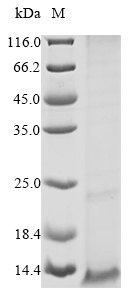Recombinant Mouse Reactive oxygen species modulator 1 (Romo1) is produced through an in vitro E.coli expression system and covers the full-length protein sequence from amino acids 1 to 79. The protein includes an N-terminal 10xHis-tag, which makes purification and detection more straightforward. SDS-PAGE analysis shows that Romo1 purity exceeds 85%, suggesting reliable performance for research work. This product is strictly for research use and should not be used for diagnostic or therapeutic purposes.
Reactive oxygen species modulator 1 (Romo1) appears to play an important role in how cells handle oxidative stress by managing reactive oxygen species (ROS) levels. The protein seems integral to various cellular pathways, particularly those involving mitochondrial function and oxidative stress responses. Research into Romo1 may be essential for understanding how it contributes to cellular balance and what this might mean for oxidative stress-related studies.
Potential Applications
Note: The applications listed below are based on what we know about this protein's biological functions, published research, and experience from experts in the field. However, we haven't fully tested all of these applications ourselves yet. We'd recommend running some preliminary tests first to make sure they work for your specific research goals.
While the in vitro E. coli expression system can produce soluble protein and allows some control over folding conditions, it completely lacks the mitochondrial membrane environment and specific chaperones essential for Romo1's correct integration and native folding. The protein is highly unlikely to achieve its functional, membrane-embedded conformation. Its biological activity in ROS regulation is suspect without validation in a proper membrane context. This application is not recommended. A misfolded, soluble version of a membrane protein is prone to massive non-specific (false-positive) hydrophobic interactions. It will not be integrated into a membrane and thus cannot interact with partners in its physiological context, leading to false negatives. Any interaction data would be uninterpretable and misleading.
1. Antibody Development and Validation
This recombinant Romo1 serves as a suitable immunogen for generating antibodies against the linear sequence of the protein. The full-length design ensures coverage of all potential linear epitopes. Antibodies produced against this non-membrane-associated antigen will likely be most effective for detecting denatured Romo1 (e.g., in Western blots). However, it may be limited to use these antibodies to study the native Romo1 protein.
2. Biochemical Characterization and Stability Studies
This is the essential first step to characterize the biophysical properties of this specific protein preparation. Techniques like SEC-MALS (Size Exclusion Chromatography with Multi-Angle Light Scattering) and CD (Circular Dichroism) can determine its oligomeric state, stability, and secondary structure in solution. This data is critical for understanding the protein's quality but describes the properties of a misfolded soluble variant, not the native membrane protein.
3. ELISA Development and Quantification Assays
This Romo1 protein is well-suited as a quantitative standard in an ELISA designed to measure the total concentration of Romo1 in a sample (e.g., a denatured lysate). The assay relies on antibody binding to linear epitopes, so the protein's non-native conformation is not a limitation for this specific application.
Final Recommendation & Action Plan
The expression system is fundamentally mismatched with the native biology of this membrane protein, severely limiting its functional applications. The immediate and mandatory first step is Application 2 (Biochemical Characterization) to understand the physical properties of the produced protein. It can be reliably used for Application 3 (as an ELISA standard) and Application 1 (Antibody Development against linear epitopes). For any functional investigation of Romo1 (interactions, activity), the only scientifically valid path is to study the protein in its correct cellular context, either by immunoprecipitating the endogenous protein from mammalian cells or by using a eukaryotic expression system that can target Romo1 to the mitochondrial membrane.






